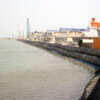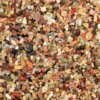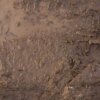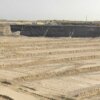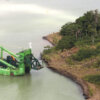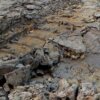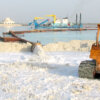Soft clays or soft silts in the reclamation area will become soft slurry, and slurry can result in significant bulking followed by consolidation.
During dredging and discharging water is added and, depending on the initial density and dredging method, significant bulking can occur and then consolidation follows.
Self-weight consolidation
After disposal onto the reclamation area, the slurry will consolidate under its own weight. The resulting density on the reclamation area is strongly related to the clay content of the soil.
Data suggest that the water content of clays and silts immediately after settling from a slurry will equal 1.5 to 2.0 times their liquid limit. With time the water content will reduce and the shear strength will increase as a result of self-weight consolidation and desiccation (only above water).
Ripening of clay above the waterline
In case soft clays or silts are disposed above the waterline, these layers can be left exposed in order to ripen and make them suitable for construction purposes. The ripening of clay is a combination of desiccation and chemical processes ultimately resulting in a workable clay.
Other consolidation methods
Alternatively the strength of soft clay or silt can be improved by using consolidation techniques such as surcharging, vacuum consolidation, and other methods. These techniques can be applied above and below the waterline.
The disposed material will behave as any natural soil deposit, although it might be more homogeneous than a natural clay or silt deposit.
Soft organic clay or silt
Because of its high compressibility, materials with a large organic content are not suitable for construction fill. Oxidation or decomposition of the organic component can cause a decrease in volume up to 50 percent. Low shear strength increases the risk of slope failure. Low permeability can also be a problem.
Peat and soft clay can be used for non-construction applications as long as there is no requirement for height, bearing capacity and stability.




